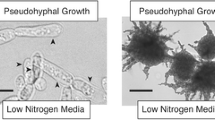Abstract
The yeast Saccharomyces cerevisiae has given us much information on the metabolism and function of inositol polyphosphates and inorganic polyphosphate. To expand our knowledge of the metabolic as well as functional connections between inositol polyphosphates and inorganic polyphosphate, we have refined and developed techniques to extract and analyze these molecules in a second eukaryotic experimental model, the amoeba Dictyostelium discoideum. This amoeba, possessing a well-defined developmental program, is ideal to study physiological changes in the levels of inositol polyphosphates and inorganic polyphosphate, since levels of both molecules increase at late stages of development. We detail here the methods used to extract inositol polyphosphates using perchloric acid and inorganic polyphosphate using acidic phenol. We also present the postextraction procedures to visualize and quantify these molecules by polyacrylamide gel electrophoresis and by malachite green assay.
Access this chapter
Tax calculation will be finalised at checkout
Purchases are for personal use only
Similar content being viewed by others
References
Azevedo C, Saiardi A (2014) Functions of inorganic polyphosphates in eukaryotic cells: a coat of many colours. Biochem Soc Trans 42(1):98–102. https://doi.org/10.1042/BST20130111
Rao NN, Gomez-Garcia MR, Kornberg A (2009) Inorganic polyphosphate: essential for growth and survival. Annu Rev Biochem 78:605–647. https://doi.org/10.1146/annurev.biochem.77.083007.093039
Michell RH (2008) Inositol derivatives: evolution and functions. Nat Rev Mol Cell Biol 9(2):151–161. nrm2334 [pii]. https://doi.org/10.1038/nrm2334
Livermore TM, Azevedo C, Kolozsvari B, Wilson MS, Saiardi A (2016) Phosphate, inositol and polyphosphates. Biochem Soc Trans 44(1):253–259. https://doi.org/10.1042/BST20150215
Shears SB (2015) Inositol pyrophosphates: why so many phosphates? Adv Biol Regul 57:203–216. https://doi.org/10.1016/j.jbior.2014.09.015
Wilson MS, Livermore TM, Saiardi A (2013) Inositol pyrophosphates: between signalling and metabolism. Biochem J 452(3):369–379. https://doi.org/10.1042/BJ20130118
Lonetti A, Szijgyarto Z, Bosch D, Loss O, Azevedo C, Saiardi A (2011) Identification of an evolutionarily conserved family of inorganic polyphosphate endopolyphosphatases. J Biol Chem 286(37):31966–31974. M111.266320 [pii]. https://doi.org/10.1074/jbc.M111.266320
Wild R, Gerasimaite R, Jung JY, Truffault V, Pavlovic I, Schmidt A, Saiardi A, Jessen HJ, Poirier Y, Hothorn M, Mayer A (2016) Control of eukaryotic phosphate homeostasis by inositol polyphosphate sensor domains. Science 352(6288):986–990. https://doi.org/10.1126/science.aad9858
Odom AR, Stahlberg A, Wente SR, York JD (2000) A role for nuclear inositol 1,4,5-trisphosphate kinase in transcriptional control. Science 287(5460):2026–2029
Saiardi A, Caffrey JJ, Snyder SH, Shears SB (2000) The inositol hexakisphosphate kinase family. Catalytic flexibility and function in yeast vacuole biogenesis. J Biol Chem 275(32):24686–24692
Saiardi A, Caffrey JJ, Snyder SH, Shears SB (2000) Inositol polyphosphate multikinase (ArgRIII) determines nuclear mRNA export in Saccharomyces cerevisiae. FEBS Lett 468(1):28–32
Saiardi A, Erdjument-Bromage H, Snowman AM, Tempst P, Snyder SH (1999) Synthesis of diphosphoinositol pentakisphosphate by a newly identified family of higher inositol polyphosphate kinases. Curr Biol 9(22):1323–1326
York JD, Odom AR, Murphy R, Ives EB, Wente SR (1999) A phospholipase C-dependent inositol polyphosphate kinase pathway required for efficient messenger RNA export. Science 285(5424):96–100
Saiardi A, Resnick AC, Snowman AM, Wendland B, Snyder SH (2005) Inositol pyrophosphates regulate cell death and telomere length through phosphoinositide 3-kinase-related protein kinases. Proc Natl Acad Sci U S A 102(6):1911–1914
Saiardi A, Sciambi C, McCaffery JM, Wendland B, Snyder SH (2002) Inositol pyrophosphates regulate endocytic trafficking. Proc Natl Acad Sci U S A 99(22):14206–14211
York SJ, Armbruster BN, Greenwell P, Petes TD, York JD (2005) Inositol diphosphate signaling regulates telomere length. J Biol Chem 280(6):4264–4269
Lander N, Ulrich PN, Docampo R (2013) Trypanosoma brucei vacuolar transporter chaperone 4 (TbVtc4) is an acidocalcisome polyphosphate kinase required for in vivo infection. J Biol Chem 288(47):34205–34216. https://doi.org/10.1074/jbc.M113.518993
Zhang H, Gomez-Garcia MR, Shi X, Rao NN, Kornberg A (2007) Polyphosphate kinase 1, a conserved bacterial enzyme, in a eukaryote, dictyostelium discoideum, with a role in cytokinesis. Proc Natl Acad Sci U S A 104(42):16486–16491. 0706847104 [pii]. https://doi.org/10.1073/pnas.0706847104
Livermore TM, Chubb JR, Saiardi A (2016) Developmental accumulation of inorganic polyphosphate affects germination and energetic metabolism in dictyostelium discoideum. Proc Natl Acad Sci U S A 113(4):996–1001. https://doi.org/10.1073/pnas.1519440113
Europe-Finner GN, Gammon B, Newell PC (1991) Accumulation of [3H]-inositol into inositol polyphosphates during development of dictyostelium. Biochem Biophys Res Commun 181(1):191–196
Newell PC, Europe-Finner GN, Small NV, Liu G (1988) Inositol phosphates, G-proteins and ras genes involved in chemotactic signal transduction of dictyostelium. J Cell Sci 89(Pt 2):123–127
Stephens LR, Irvine RF (1990) Stepwise phosphorylation of myo-inositol leading to myo-inositol hexakisphosphate in Dictyostelium. Nature 346(6284):580–583
Stephens L, Radenberg T, Thiel U, Vogel G, Khoo KH, Dell A, Jackson TR, Hawkins PT, Mayr GW (1993) The detection, purification, structural characterization, and metabolism of diphosphoinositol pentakisphosphate(s) and bisdiphosphoinositol tetrakisphosphate(s). J Biol Chem 268(6):4009–4015
Losito O, Szijgyarto Z, Resnick AC, Saiardi A (2009) Inositol pyrophosphates and their unique metabolic complexity: analysis by gel electrophoresis. PLoS One 4(5):e5580. https://doi.org/10.1371/journal.pone.0005580
Pisani F, Livermore T, Rose G, Chubb JR, Gaspari M, Saiardi A (2014) Analysis of Dictyostelium discoideum inositol pyrophosphate metabolism by gel electrophoresis. PLoS One 9(1):e85533. https://doi.org/10.1371/journal.pone.0085533
Smith SA, Morrissey JH (2007) Sensitive fluorescence detection of polyphosphate in polyacrylamide gels using 4′,6-diamidino-2-phenylindol. Electrophoresis 28(19):3461–3465. https://doi.org/10.1002/elps.200700041
Loss O, Azevedo C, Szijgyarto Z, Bosch D, Saiardi A (2011) Preparation of quality inositol pyrophosphates. J Vis Exp (55):e3027. https://doi.org/10.3791/3027
Acknowledgments
We thank the Saiardi lab for suggestions and reading of the manuscript. This work was supported by the Medical Research Council (MRC) core support to the MRC/UCL Laboratory for Molecular Cell Biology University Unit MC_UU_12018/4 and MC_UU_00012/4. YD was supported by a Marie Skłodowska-Curie grant (agreement PHEMDD No 752903).
Author information
Authors and Affiliations
Corresponding author
Editor information
Editors and Affiliations
Rights and permissions
Copyright information
© 2020 Springer Science+Business Media, LLC, part of Springer Nature
About this protocol
Cite this protocol
Desfougères, Y., Saiardi, A. (2020). Dictyostelium discoideum as a Model to Study Inositol Polyphosphates and Inorganic Polyphosphate. In: Miller, G. (eds) Inositol Phosphates. Methods in Molecular Biology, vol 2091. Humana, New York, NY. https://doi.org/10.1007/978-1-0716-0167-9_5
Download citation
DOI: https://doi.org/10.1007/978-1-0716-0167-9_5
Published:
Publisher Name: Humana, New York, NY
Print ISBN: 978-1-0716-0166-2
Online ISBN: 978-1-0716-0167-9
eBook Packages: Springer Protocols




